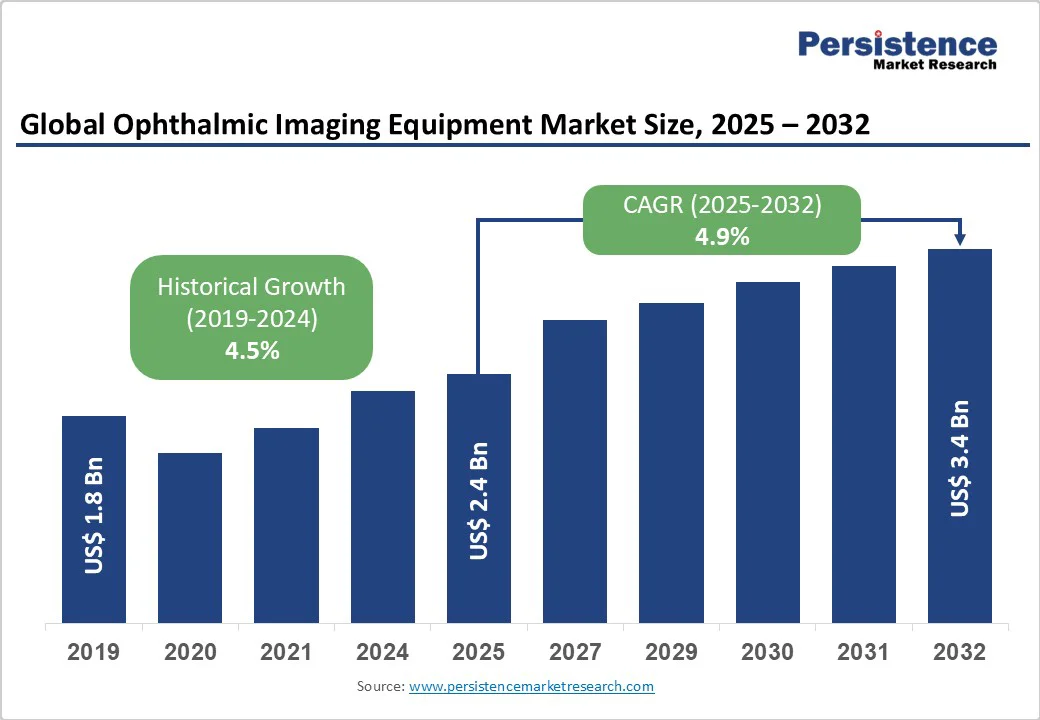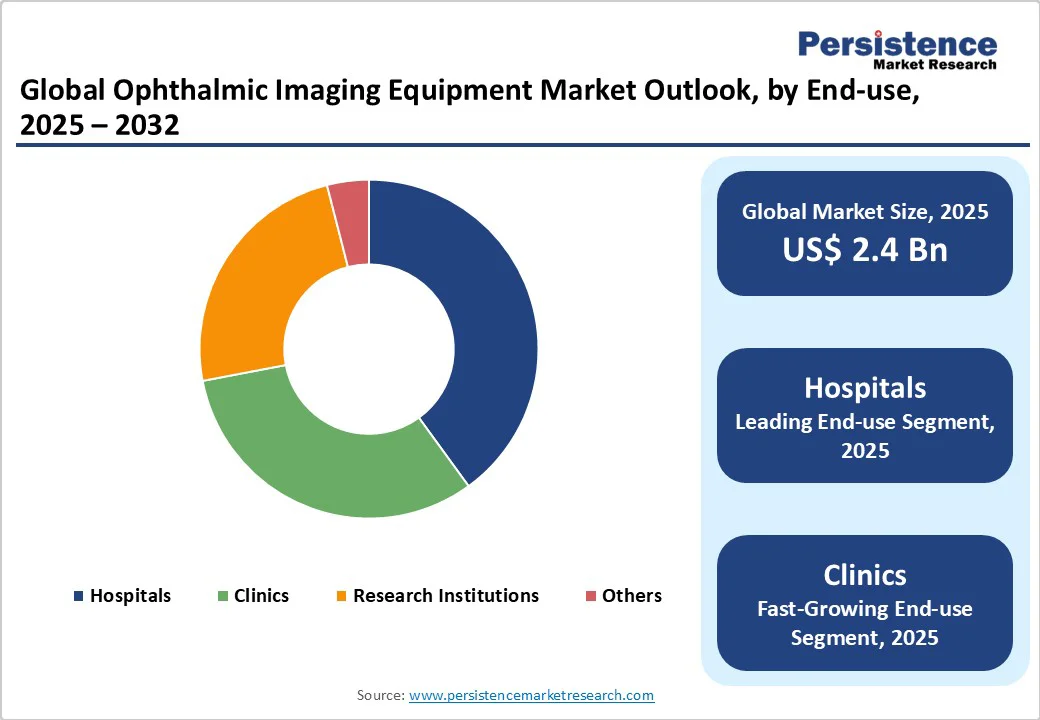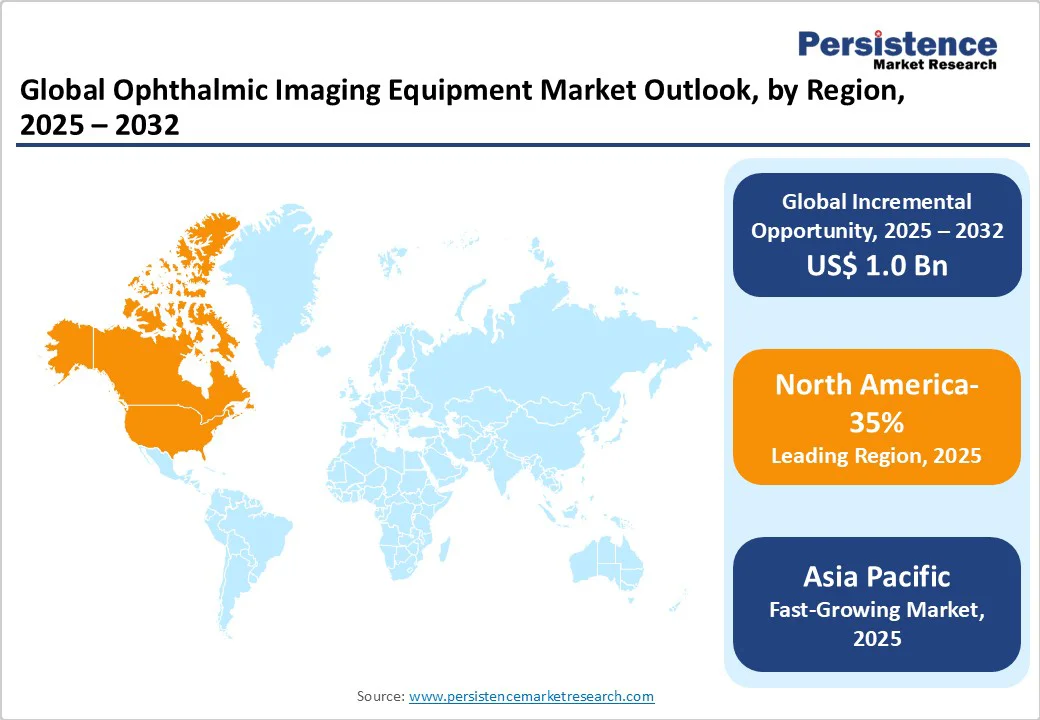ID: PMRREP31786| 185 Pages | 10 Oct 2025 | Format: PDF, Excel, PPT* | Healthcare

The global ophthalmic imaging equipment market is expected to be valued at US$2.4 billion by 2025. It is estimated to reach US$3.4 billion by 2032, growing at a CAGR of 4.9% during the forecast period from 2025 to 2032.
The increasing prevalence of eye disorders, including diabetic retinopathy, glaucoma, and age-related macular degeneration, is driving demand for advanced imaging solutions.
| Global Market Attribute | Key Insights |
|---|---|
| Ophthalmic Imaging Equipment Market Size (2025E) | US$2.4 Bn |
| Market Value Forecast (2032F) | US$3.4 Bn |
| Projected Growth (CAGR 2025 to 2032) | 4.9% |
| Historical Market Growth (CAGR 2019 to 2024) | 4.5% |

The rising prevalence of eye disorders is a major driver of the ophthalmic imaging equipment market. Globally, more than 2.2 billion people are affected by vision impairment or blindness, caused largely by conditions such as diabetic retinopathy, glaucoma, cataracts, and age-related macular degeneration.
For instance, India’s National Diabetes & Diabetic Retinopathy Survey (2015-2019) reported that 11.8% of people aged 50 years and above were diabetic, with 16.9% of them showing signs of diabetic retinopathy. These findings underscore the growing need for early detection, accurate diagnosis, and advanced screening solutions to prevent preventable vision loss.
At the same time, technological advancements are reshaping ophthalmic imaging. AI-integrated retinal imaging, optical coherence tomography (OCT), and portable fundus cameras now offer faster, more precise, and non-invasive diagnostics. These innovations enhance accessibility to eye care, support large-scale screening programs, and improve treatment outcomes, thereby boosting the adoption of ophthalmic imaging equipment worldwide.
The ophthalmic imaging equipment market faces significant restraint due to the high costs associated with advanced technologies. Devices such as optical coherence tomography (OCT), fundus cameras, and AI-enabled imaging systems require substantial investments in acquisition, maintenance, and training of skilled personnel. This cost burden limits adoption, particularly among small clinics and standalone diagnostic centers, thereby reducing patient accessibility in low- and middle-income regions.
Limited accessibility in emerging markets further slows growth. Inadequate healthcare infrastructure, shortage of trained ophthalmologists, and low public awareness hinder widespread use of imaging equipment. Additionally, reimbursement challenges and limited government funding in many countries restrict the adoption of advanced diagnostic tools. These factors collectively create barriers to market penetration, restraining market expansion despite rising demand for early detection of eye diseases.
Artificial intelligence (AI) integration presents a strong opportunity for the ophthalmic imaging equipment market. AI-driven diagnostic tools enhance the accuracy and speed of detecting conditions such as diabetic retinopathy, glaucoma, and macular degeneration.
By enabling automated image analysis, AI reduces the burden on ophthalmologists, supports large-scale screening, and improves early disease detection rates. This technology also facilitates teleophthalmology, expanding access to specialized care in underserved and remote areas.
Emerging markets further offer vast growth potential due to rising healthcare investments, improving infrastructure, and growing awareness of vision care. Governments in the Asia Pacific, Latin America, and Africa are prioritizing preventive eye care, which creates opportunities for manufacturers to introduce cost-effective, portable, and AI-enabled imaging devices. Together, AI adoption and emerging market expansion are expected to accelerate industry growth.
Retina and glaucoma examination products are expected to hold the largest share of the ophthalmic imaging equipment market, accounting for around 45% in 2025. Their dominance stems from the rising burden of retinal disorders and glaucoma, both of which remain leading causes of vision loss worldwide. The increasing use of advanced imaging technologies, such as OCT and fundus cameras, for accurate diagnosis and long-term monitoring continues to drive the growth of this segment.
Cornea and cataract examination products are anticipated to witness the fastest growth. The surge in cataract cases among the elderly population and the rising prevalence of corneal disorders are driving demand. Advancements in corneal topography, slit-lamp imaging, and the expansion of surgical procedures are further accelerating the adoption of these technologies.
Hospitals are projected to dominate the ophthalmic imaging equipment market in 2025, accounting for nearly 40% of the total share. Their dominance is driven by advanced infrastructure, a higher patient inflow, and the availability of specialized ophthalmologists for managing complex eye diseases. Hospitals also have greater financial capacity to invest in high-cost imaging systems such as OCT, fundus cameras, and AI-enabled diagnostic platforms, strengthening their leadership.
Clinics, however, represent the fastest-growing segment of end-users. Increasing demand for accessible and affordable eye care, coupled with rising adoption of portable and user-friendly imaging devices, is fueling their rapid expansion. Clinics play a vital role in community-level screening and early detection, making them a key driver of market penetration.

North America is set to dominate the ophthalmic imaging equipment market in 2025, capturing nearly 35% of the total share. The high prevalence of vision-related disorders such as glaucoma, diabetic retinopathy, and age-related macular degeneration drives this dominance.
Advanced healthcare infrastructure, combined with the strong adoption of cutting-edge technologies such as OCT and fundus cameras, and favorable reimbursement policies, further strengthens the region’s position. In addition, the presence of leading manufacturers and the growing integration of AI-enabled imaging solutions ensure that North America remains at the forefront of innovation and market growth.
Europe is expected to hold a significant share of the ophthalmic imaging equipment market in 2025, driven by the rising prevalence of cataracts, glaucoma, and age-related macular degeneration. Advanced healthcare infrastructure, widespread adoption of innovative diagnostic technologies, and growing awareness of preventive eye care are driving demand across the region.
In addition, increased research investments, favorable government initiatives, and strong collaborations between medical device manufacturers and healthcare institutions further reinforce Europe’s position in the global landscape.
Asia Pacific is projected to be the fastest-growing region in the ophthalmic imaging equipment market by 2025, driven by a rising burden of vision disorders, an expanding elderly population, and a growing prevalence of diabetes-related eye diseases.
Improving healthcare infrastructure, increasing government investments in preventive care, and rapid adoption of advanced diagnostic technologies are fueling demand across countries such as China, India, and Japan. In addition, expanding teleophthalmology programs and greater accessibility to affordable imaging devices are enabling early detection in rural and underserved areas, positioning the Asia Pacific as a key growth engine in the global industry.

The global ophthalmic imaging equipment market is highly competitive, driven by continuous technological innovation and product differentiation. Companies focus on developing advanced imaging systems, AI-enabled diagnostic solutions, and portable devices to strengthen their market presence.
Strategic initiatives such as mergers, partnerships, and regional expansions are commonly employed to capture new markets and enhance distribution networks. Additionally, investments in research and development to improve accuracy, efficiency, and patient accessibility are intensifying competition, fostering rapid innovation and driving overall industry growth.
The ophthalmic imaging equipment market is projected to reach US$2.4 bn in 2025, driven by rising eye disorders and technological advancements.
Increasing prevalence of glaucoma and AMD, aging population, and AI-integrated diagnostics fuel market growth.
The ophthalmic imaging equipment market will grow from US$2.4 bn in 2025 to US$3.4 bn by 2032, with a CAGR of 4.9%.
AI integration and emerging market expansion drive opportunities in portable and affordable imaging.
Leading players include Essilor Instruments, Haag-Streit AG, Carl Zeiss AG, Johnson & Johnson Vision Care, Alcon, Canon Inc., Quantel Medical Inc., Halma plc., Nidek Co., Ltd., and Topcon Corporation.
| Report Attribute | Details |
|---|---|
| Historical Data/Actuals | 2019 - 2024 |
| Forecast Period | 2025 - 2032 |
| Market Analysis | Value: US$ Bn, Volume: As Applicable |
| Geographical Coverage |
|
| Segmental Coverage |
|
| Competitive Analysis |
|
| Report Highlights |
|
By Product Type
By End-use
By Region
Delivery Timelines
For more information on this report and its delivery timelines please get in touch with our sales team.
About Author